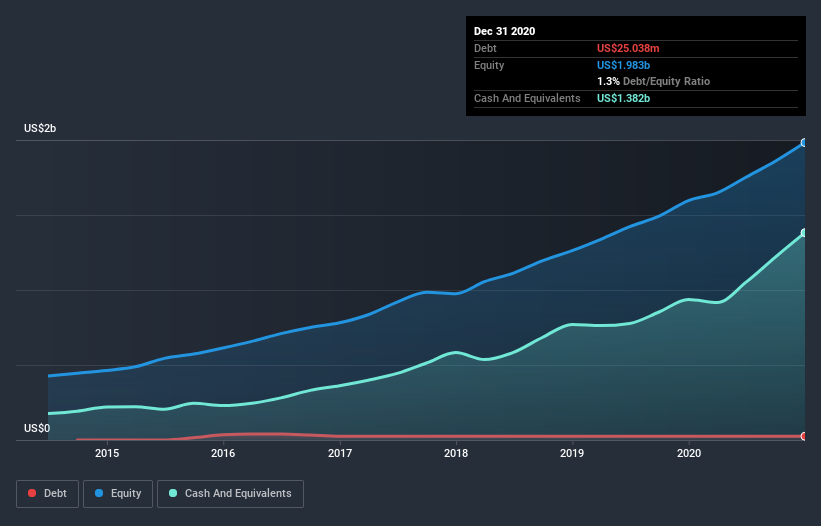EPAM Systems (NYSE:EPAM) Seems To Use Debt Rather Sparingly
Warren Buffett famously said, 'Volatility is far from synonymous with risk.' When we think about how risky a company is, we always like to look at its use of debt, since debt overload can lead to ruin. We note that EPAM Systems, Inc. (NYSE:EPAM) does have debt on its balance sheet. But is this debt a concern to shareholders?
What Risk Does Debt Bring?
Debt and other liabilities become risky for a business when it cannot easily fulfill those obligations, either with free cash flow or by raising capital at an attractive price. Ultimately, if the company can't fulfill its legal obligations to repay debt, shareholders could walk away with nothing. However, a more frequent (but still costly) occurrence is where a company must issue shares at bargain-basement prices, permanently diluting shareholders, just to shore up its balance sheet. Of course, debt can be an important tool in businesses, particularly capital heavy businesses. The first thing to do when considering how much debt a business uses is to look at its cash and debt together.
Check out our latest analysis for EPAM Systems
What Is EPAM Systems's Net Debt?
As you can see below, EPAM Systems had US$25.0m of debt, at December 2020, which is about the same as the year before. You can click the chart for greater detail. But it also has US$1.38b in cash to offset that, meaning it has US$1.36b net cash.
A Look At EPAM Systems' Liabilities
Zooming in on the latest balance sheet data, we can see that EPAM Systems had liabilities of US$466.0m due within 12 months and liabilities of US$272.4m due beyond that. Offsetting this, it had US$1.38b in cash and US$501.1m in receivables that were due within 12 months. So it can boast US$1.14b more liquid assets than total liabilities.
This surplus suggests that EPAM Systems has a conservative balance sheet, and could probably eliminate its debt without much difficulty. Simply put, the fact that EPAM Systems has more cash than debt is arguably a good indication that it can manage its debt safely.
Also positive, EPAM Systems grew its EBIT by 25% in the last year, and that should make it easier to pay down debt, going forward. When analysing debt levels, the balance sheet is the obvious place to start. But it is future earnings, more than anything, that will determine EPAM Systems's ability to maintain a healthy balance sheet going forward. So if you want to see what the professionals think, you might find this free report on analyst profit forecasts to be interesting.
Finally, while the tax-man may adore accounting profits, lenders only accept cold hard cash. EPAM Systems may have net cash on the balance sheet, but it is still interesting to look at how well the business converts its earnings before interest and tax (EBIT) to free cash flow, because that will influence both its need for, and its capacity to manage debt. Over the last three years, EPAM Systems recorded free cash flow worth a fulsome 99% of its EBIT, which is stronger than we'd usually expect. That puts it in a very strong position to pay down debt.
Summing up
While we empathize with investors who find debt concerning, you should keep in mind that EPAM Systems has net cash of US$1.36b, as well as more liquid assets than liabilities. The cherry on top was that in converted 99% of that EBIT to free cash flow, bringing in US$476m. So we don't think EPAM Systems's use of debt is risky. Another factor that would give us confidence in EPAM Systems would be if insiders have been buying shares: if you're conscious of that signal too, you can find out instantly by clicking this link.
At the end of the day, it's often better to focus on companies that are free from net debt. You can access our special list of such companies (all with a track record of profit growth). It's free.
This article by Simply Wall St is general in nature. It does not constitute a recommendation to buy or sell any stock, and does not take account of your objectives, or your financial situation. We aim to bring you long-term focused analysis driven by fundamental data. Note that our analysis may not factor in the latest price-sensitive company announcements or qualitative material. Simply Wall St has no position in any stocks mentioned.
Have feedback on this article? Concerned about the content? Get in touch with us directly. Alternatively, email editorial-team (at) simplywallst.com.

